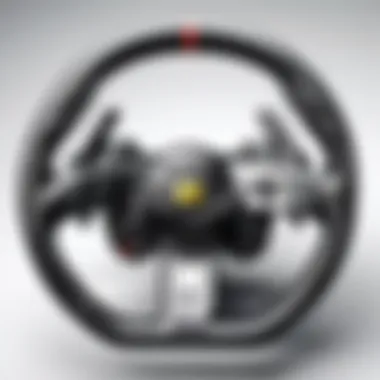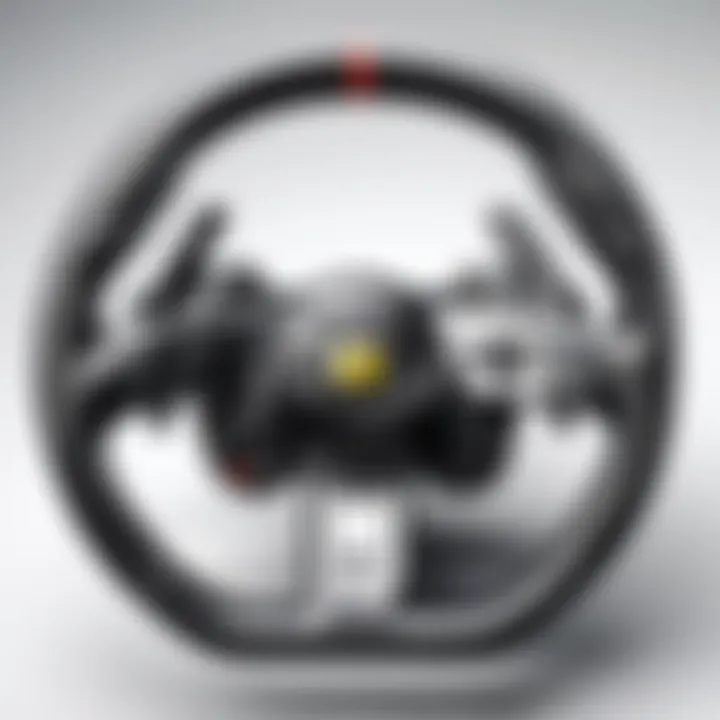Understanding Racing Wheels for PS4: An In-Depth Analysis


Intro
Racing wheels have grown significantly in popularity among gamers, particularly those using the PlayStation 4. With advancements in technology, these devices provide a more immersive racing experience compared to standard controllers. Understanding how to choose the right racing wheel is essential for enhancing gameplay and performance. This article offers a detailed exploration of various elements related to PS4 racing wheels, including their technical specifications, product comparisons, practical applications, latest trends, and helpful buying guides.
Technical Specifications
Detailed Product Specs
When evaluating racing wheels, it’s important to consider several key specifications. Most high-quality wheels feature force feedback capabilities, which simulate the sensations of real driving. This includes the feel of steering resistance, road bumps, and tire traction. Look for wheels that offer varying degrees of adjustability in sensitivity, as this can impact overall performance.
Another noteworthy spec is the wheel size. Different models come in various diameters, typically ranging from 11 to 13.5 inches. A larger wheel may provide more realism during gameplay, while smaller wheels can offer quicker response times.
Additionally, pedals are a critical part of the setup. Investigate whether the pedal unit is included with the wheel and look for features such as an adjustable brake pedal, which allows for personalized brake sensitivity.
Performance Metrics
Evaluating performance metrics involves considering reaction time, accuracy, and durability. A high-end racing wheel should deliver quick response times, ensuring every input is registered immediately. Feedback from users often indicates that durability can vary significantly between models, making customer reviews an essential resource. Performance metrics should align with user needs, whether that means casual racing or competitive play.
Compatibility Information
Not all racing wheels are universally compatible. Many models are specifically designed for the PlayStation 4, so it is crucial to verify compatibility before purchasing. Check manufacturer details to ensure that the wheel works seamlessly with the PS4 system. Additionally, some wheels offer multi-platform compatibility, allowing use with PCs or other consoles.
Product Comparisons
Feature Comparisons
When contrasting different racing wheels, it is helpful to consider essential features like force feedback strength, compatibility, and build quality. For example, the Thrustmaster T300 RS GT offers robust force feedback and a sturdy build, compared to the Logitech G923, which has a more straightforward design but still delivers solid performance and compatibility.
Price Breakdown
Price can greatly influence purchasing decisions. Models like the Fanatec CSL Elite wheel typically sit at the higher end of the pricing spectrum, while brands such as Hori offer more budget-friendly options without sacrificing too much on functionality. It’s essential to analyze whether the price aligns with the features offered and personal gaming habits.
User Experience Breakdown
User experiences tend to vary widely. Many users express a preference for the tactile feel and overall immersion provided by higher-end models. Others find that entry-level wheels with basic features still fulfill their gaming needs adequately. Reading reviews from various sources such as Reddit or specialized gamer forums can provide valuable insights.
Practical Applications
Use Cases for Different Users
Understanding the various applications of racing wheels enhances their value. Casual gamers might be satisfied with simpler models that focus on affordability and basic functionality, while more serious racers will likely seek advanced features for an authentic experience.
Recommended Configurations
Configuration depends on the user's skill level and gaming setup. A mid-range pedal unit paired with a high-quality wheel provides an excellent balance for most players. Ensure the wheel is mounted securely, as a wobbly setup can hinder performance.
Multi-Platform Performances
Some racing wheels support multiple platforms. This capability can be beneficial for users who switch between consoles or PCs. Be aware of compatibility with specific games, as not all titles support every wheel model.
Latest Trends
Industry Developments
The racing wheel industry has seen various developments lately, including improved force feedback systems and enhanced pedal responsiveness. Innovations focus on creating more lifelike experiences for users, contributing to overall enjoyment.
Emerging Technologies
Emerging technologies can include bespoke software for fine-tuning wheel settings and customizable firmware. Some advanced models even allow for integration with virtual reality systems, creating an unparalleled immersive environment.
Future Predictions
As gaming technology advances, we can expect even greater realism in racing wheels. More brands may introduce adaptive technology that personalizes the gaming experience, catering to individual preferences.
Buying Guides
Recommended Products
For those beginning in the world of racing wheels, the Logitech G923 is often recommended for its balance of quality and price. In contrast, the Fanatec GT CSL Elite is ideal for dedicated racers seeking top-notch performance.
Purchasing Tips
When looking for a racing wheel, set a budget and outline key features you need. Always check for compatibility with your PS4 system and other devices. Consider trying out wheels in gaming stores if possible.
Warranty and Support Information
Consider potential warranty options when investing. Good support from the manufacturer can be invaluable if issues arise. Research each product’s warranty terms before making a final decision.
Prolusion to Racing Wheels for PS4


Racing wheels for the PlayStation 4 represent a significant advancement in gaming peripherals that cater to simulation racing enthusiasts. The topic is critical, as these devices enhance the immersive experience of racing games. By providing real-time feedback and improved control, they allow players to perform better and feel more engaged with the game.
The racing wheel not only optimizes gameplay but also replicates real-world steering and driving feel. This can lead to a more satisfying experience compared to using a standard controller. Furthermore, understanding racing wheels can aid in making informed purchasing decisions, as various features and price points exist in the market. Hence, grasping the nuances of racing wheels is essential for any serious gamer looking to elevate their racing experience.
The Rise of Sim Racing
The past decade has seen a surge in the popularity of sim racing. This genre appeals not only to traditional gamers but also to a broader audience fascinated by motorsport and technical driving. Factors contributing to this rise include improved gaming graphics, realistic physics engines, and an expanding library of racing titles, many of which are available on consoles like the PS4.
As sim racing has become more mainstream, manufacturers have responded by producing high-quality racing wheels with advanced features aimed at this growing audience. Brands now prioritize realism and performance in their designs, which is evident in the features offered by their products. The rise of esports has further fueled interest in sim racing, making racing wheels a focal point for competitive play. Overall, it underscores the transformation of gaming as more than just a pastime, but as a serious form of sport.
PS4's Impact on Racing Games
The PlayStation 4 has had a substantial impact on the racing genre, becoming a preferred platform for many racing enthusiasts. It hosts a variety of racing games, from arcade-style offerings to authentic simulators. Titles like Gran Turismo Sport and F1 2021 illustrate the platform's diversity, drawing in both casual and hardcore gamers.
The PS4 enhances the interaction between the gaming wheel and the software, with many titles explicitly optimized for use with racing wheels. This synergy increases the realism and enjoyment of the gaming experience. Additionally, the availability of exclusive games on the PS4 solidifies its status in the racing community.
The impact of the PS4 extends beyond just the games themselves. The console’s features like online multiplayer and community engagement enable players to share experiences and compete globally. Thus, the PS4 does not only facilitate access to racing games, it cultivates a vibrant racing culture that invites deeper investment in racing wheels for an authentic experience.
Key Features of Racing Wheels
When considering a racing wheel for the PlayStation 4, understanding key features becomes crucial. These elements significantly impact your gaming experience and can be the difference between a mediocre simulation and an authentic racing experience. From the force feedback mechanism to the ergonomics of wheel size, each feature lends itself to improving gameplay. The importance of these components cannot be overstated, as they affect not only how one interacts with the game but also the realism and immersion levels one can achieve.
Force Feedback Mechanism
The force feedback mechanism is a fundamental aspect that enables a racing wheel to provide realistic sensations during gameplay. This feature replicates the physical forces experienced while driving. For example, you can feel the resistance when turning sharply or the vibrations when driving over uneven terrain. This heightened sense of realism makes every race more engaging.
Ultimately, choosing a wheel with strong force feedback enhances the overall experience. Look for wheels that allow you to adjust the intensity of the feedback to suit your preferences. This adds another level of customization, further investing the user in their racing experience.
Wheel Size and Ergonomics
Wheel size and ergonomics play a vital role in the comfort and performance of the racing wheel. A well-designed wheel will fit comfortably in your hands, reducing fatigue during long gaming sessions. Most racing wheels vary in size, and finding one that suits your grip is essential. Generally, a diameter of around 11 to 13 inches is ideal, providing a good balance between control and realism.
Consider how the wheel's design accommodates your natural hand position. Flat-bottom designs might appeal to some users, whereas others may prefer a more traditional round wheel. Whichever you choose, comfort should be paramount; at the end of the day, a comfortable racing wheel will lead to better performance.
Pedal Quality and Configuration
Another critical aspect is pedal quality and configuration. High-quality pedals provide a tactile feel that enhances the driving experience. Look for pedals that have adjustable resistance levels for both the brake and accelerator. This allows for fine-tuning based on personal preference.
Additionally, the layout of pedal configurations can vary. Some setups include a separate clutch pedal, which adds to the complexity of driving simulations. Ensure that the pedal set aligns with your preferences, especially if you are looking for a setup that simulates an actual racing car's controls.
In summary, the key features of racing wheels all contribute to creating a sophisticated and immersive gaming experience. When choosing a racing wheel for PS4, it is crucial to assess these elements to make an informed decision that enhances your overall gaming experience. Investing in a high-quality racing wheel based on these features will pay off in terms of enjoyment and realism.
Investing in the right racing wheel is investing in the quality of gaming experience. Each feature - from force feedback to pedal configuration - matters significantly.
Compatibility Considerations
Understanding compatibility is crucial when selecting a racing wheel for the PS4. A racing wheel that exceeds expectations in performance but lacks the required compatibility can lead to frustrating gaming experiences. This section delves into the essential compatibility factors: console compatibility, game support, and software requirements, all of which influence user satisfaction and functionality.
Console Compatibility
When purchasing a racing wheel, console compatibility is the first consideration. Not every racing wheel works with the PS4; some are specifically designed for PC or other consoles. Therefore, it is essential for users to check whether their desired model explicitly indicates compatibility with the PlayStation 4. A reliable racing wheel will often advertise compatibility directly in the product description, so checking this detail becomes a fundamental step before making a purchase.
Some brands like Logitech and Thrustmaster provide detailed lists of consoles they support with their racing wheels. This transparency helps consumers avoid mistakes that could lead to unusable equipment.
Game Support
Different racing wheels offer varying degrees of support for specific games. For instance, a high-end racing wheel might be compatible with games like Gran Turismo Sport or F1 2020, while entry-level models might not fully support the features of these games. Therefore, before choosing a racing wheel, check the specifications to see if it aligns with the games you want to play.
Some racing games have specific requirements or settings, which affect how the racing wheel performs. Features like force feedback, button layouts, and even the ability to use a clutch pedal can significantly vary depending on the game. Hence, knowing which games are essential for your gameplay can guide you in selecting a wheel that meets these needs.
"Compatibility with the game can significantly enhance your racing experience. Choose wisely."
Software Requirements
Finally, the software requirements to run a racing wheel on PS4 should not be overlooked. Many racing wheels require specific drivers or updates to function correctly. Manufacturers often provide software that allows for customization of the racing wheel settings, improving responsiveness or user interface integration with games.
Users must check if any software installation is required before starting the setup process. Some racing wheels can even benefit from firmware updates that enhance performance or compatibility with new games. Therefore, make it a priority to ensure your racing wheel will work seamlessly in conjunction with both the PS4 system and the games you wish to play.
In summary, understanding compatibility considerations helps buyers ensure their investment in a racing wheel aligns with their gaming needs, facilitating a smoother and more enjoyable racing experience.
Performance Traits
Performance traits are crucial when it comes to selecting a racing wheel for PS4. These devices need to meet specific standards of precision, responsiveness, and durability to provide an authentic gaming experience. Without these qualities, players may find it hard to gain an advantage in competitive racing games, which often rely on nuanced control and realism.
Precision and Responsiveness
Precision in racing wheels translates to how accurately movements are registered in-game. A high-performance wheel captures minute changes in steering, providing real-time feedback that enhances immersion.
Responsive wheels allow for immediate actions, which is vital in racing scenarios. Gamers can react swiftly to track conditions, improving their competitive edge.


Several factors influence precision and responsiveness:
- Sensor technology: Advanced sensors can provide finer accuracy. High-end models often utilize Hall effect sensors that minimize latency.
- Force feedback: This feature mimics the physical sensations of driving, giving players a tactile means to gauge traction and grip. Strong feedback helps improve reflexes since gamers can feel the car's reaction to their inputs.
- Wheel design: When the wheel has a larger diameter or a well-shaped grip, the player can make more precise adjustments while steering. A well-designed wheel facilitates better control and reduces error during high-speed maneuvers.
Durability and Build Quality
Durability influences the longevity of racing wheels, an aspect often overlooked. A wheel must withstand prolonged use, especially during intense gaming sessions. The materials and construction play significant roles here.
Quality build materials ensure that the racing wheel remains intact under stress. While plastic may lower costs, it can compromise durability compared to metal components or reinforced plastics.
Additionally, the performance of pedals should not be disregarded. They need to be sturdy and responsive as well. Users will benefit from:
- Robustness: A well-constructed wheel is less likely to wear down after extensive usage. Components like the wheel's base and pedal assemblies should feel solid.
- User reviews: Users often share their experiences on platforms like Reddit or gaming forums, providing insights into which models have proven their durability under pressure.
- Warranty: A reliable manufacturer will back their product with a warranty, signaling confidence in their build quality.
"Investing in a high-quality racing wheel is not just about features; it's about ensuring it will last through your gaming journey without compromise."
In summary, focusing on performance traits ensures that gamers can enjoy the full benefit of racing simulations. The wheel's precision, responsiveness, and build quality are paramount in creating a satisfactory gaming experience. Prioritizing these aspects will empower players to fully engage with their racing games, leading to enhanced performance and enjoyment.
Top Racing Wheel Models for PS4
The selection of racing wheel models for the PlayStation 4 can significantly impact gaming experience. Different models cater to various budgets, preferences, and playstyles. Understanding the range of available options helps users make informed decisions. This section will uncover recommended racing wheels depending on their price point and features, allowing consumers to match their needs with the right product.
Entry-Level Options
Entry-level racing wheels offer a fantastic way to experience sim racing without breaking the bank. These options generally provide essential features that are adequate for casual gamers. One of the most notable models in this category is the Logitech G920. This wheel is compatible with both PlayStation 4 and PC, providing versatility at a reasonable price. Its force feedback system delivers decent realism, helping gamers feel more connected to their virtual vehicles.
Another good choice for entry-level options is the Thrustmaster T150. It offers a smooth performance with an adjustable force feedback system and is well-suited for beginners looking to improve their skills. The price is affordable, making it an appealing choice for players who are trying the racing genre for the first time.
These models vary in features, but they all provide a solid foundation for anyone starting out. With pricing usually between $200 and $300, they make for an accessible entry into the world of racing simulations.
Mid-Range Competitors
Mid-range racing wheels represent a more robust investment. They offer enhanced features that appeal to serious gamers. One example is the Thrustmaster TX Racing Wheel. This model features a more advanced force feedback mechanism and a detachable GT-style wheel, which can be quite appealing for those who prefer customizations.
The Fanatec CSL Elite is also a notable mention in this category. This racing wheel is renowned for its quality build and performance. It comes with a load cell brake pedal, which provides an exceptional level of control. Players who regularly participate in racing games find that it elevates their overall gaming experience.
Pricing for these models typically ranges from $300 to $600. The investment comes with the expectation of better performance, durability, and an overall more immersive experience.
High-End Models
For dedicated racing enthusiasts, high-end models offer premium features that enrich gameplay. These wheels often provide the highest levels of performance and realism. One leading model is the Fanatec Podium Racing Wheel F1. It offers incredible technology with strong direct-drive force feedback, which delivers astonishing precision.
Another top competitor is the Logitech G923. This model can be seen as a slightly more affordable yet high-performing option. It features TRUEFORCE technology, which enhances the realism by considering physics beyond the wheel. It integrates seamlessly with popular racing titles on PS4.
High-end racing wheels usually come at a steep price, often exceeding $600. However, the investment reflects the quality, providing users with a profound and enjoyable gaming experience that truly elevates their sim racing sessions.
"Investing in the right racing wheel can define your gaming experience. It is not just about playing; it's about immersive engagement in the racing world."
In summary, whether one looks for budget-friendly options or premium models, the key is to find the racing wheel that aligns best with personal preferences and gaming goals. Consider the features, performance, and price when making a decision.
User Experience and Feedback
User experience and feedback are essential in the context of racing wheels for PS4. As gamers engage with these peripherals, their subjective impressions and preferences can greatly influence purchasing decisions and product development. The way players perceive the racing wheel's performance directly impacts their overall gaming satisfaction. Thus, understanding user experiences becomes crucial.
A well-designed racing wheel should provide a seamless connection with the game. This means intuitive controls, responsive feedback, and comfort during extended sessions. A device that fails in these areas often receives poor evaluations. Players express their thoughts through reviews, helping others determine if a certain model meets their gaming requirements.
Moreover, feedback can shape future releases. Manufacturers use user experience insights to address shortcomings and enhance features, ensuring that new iterations of racing wheels are better aligned with consumer expectations. Thus, the cycle of receiving feedback and improving products is vital.
Gamer Reviews
Reviews from gamers serve as valuable resources when evaluating racing wheels. They often focus on several key factors, like build quality, ease of setup, and the overall driving experience. Positive reviews often highlight the immersive feeling provided by force feedback and precise controls.
Many gamers share detailed reviews on platforms like Reddit and specialized forums. These insights can reveal hidden benefits or drawbacks that are not apparent in official product descriptions. For example, a review may mention how the Thrustmaster T300 RS offers outstanding responsiveness, making it ideal for racing simulators.
Conversely, negative reviews usually point to issues such as uncomfortable ergonomics or unreliable software compatibility. Understanding these aspects can help others avoid potential pitfalls. On forums, user discussions often dive into personal experiences, creating a rich tapestry of information.
Usage Scenarios
Usage scenarios illustrate how racing wheels are applied in real-world settings. Not all gamers approach racing the same way. Some may engage in casual play, while others seek competitive racing experiences.
- Casual Gamers: These users might prefer simpler setups. A model like the Logitech G920 could be sufficient for those playing for fun without needing to invest heavily.
- Competitive Racers: For serious racers, high-end models such as the Fanatec CSL Elite provide superior feedback and customizability. These users often participate in online leagues, demanding precise control.
- VR Integration: Some users employ racing wheels paired with VR setups. This convergence creates a more immersive experience. Brands like Thrustmaster have designed products specifically optimized for VR environments. As VR technology continues to improve, more gamers are likely to invest in setups integrating racing wheels and virtual reality.
Price Considerations
The topic of price considerations is essential in understanding racing wheels for PS4. As gaming peripherals, racing wheels vary greatly in cost. This price range can significantly impact a consumer's decision, especially for tech-savvy individuals who seek value and quality. Knowing how to allocate a budget effectively for a racing wheel is crucial to enhancing the gaming experience while not overspending on features that may go unused.
Budgeting for a Racing Wheel
Setting a budget for a racing wheel starts with evaluating your gaming habits and preferences. Factors like the frequency of racing games played, the types of games, and the desired features all play roles in what is considered a fair price. Entry-level racing wheels, like the Logitech G920, provide essential functionality for around $200. In contrast, high-end models such as the Fanatec CSL Elite can exceed $1,000, offering advanced technology and features.


When budgeting, consider the following:
- Usage Frequency: If racing games are played regularly, investing in a quality wheel may be justified.
- Feature Set: Decide on which features are essential, such as force feedback, pedal quality, and build materials.
- Compatibility: Ensure that the wheel is compatible with PS4 and future console upgrades.
Understanding these elements enables informed decisions. You might also want to account for potential future upgrades or add-ons, such as a dedicated stand or chair for an immersive setup.
Long-Term Value Assessment
Long-term value assessment involves evaluating the return on investment of a racing wheel over time. A lower-priced unit might save money initially but could lack durability or essential features, leading to dissatisfaction. In contrast, a higher-priced model may provide better simulation, comfort, and longevity, ultimately offering more significant enjoyment and engagement.
Key points to evaluate:
- Build Quality: A well-constructed racing wheel will endure frequent use.
- Support and Warranty: Reviewing the warranty terms and support services can indicate how the manufacturer backs its quality claims.
- Technology Upgrades: As racing games evolve, the functionality of the wheel, such as feedback mechanisms and compatibility with new games, becomes important.
Ultimately, understanding the price and long-term value of a racing wheel can guide consumers to make choices aligning with their gaming style and budget. This knowledge can ensure you get the most value for your investment, enhancing the overall racing experience.
Setup and Installation
The setup and installation of a racing wheel for the PlayStation 4 is a crucial phase that can significantly affect user experience. A proper installation ensures that the device functions optimally and integrates seamlessly with the console and racing games. This segment focuses on the steps necessary for setting up a racing wheel, alongside the calibration process that enhances performance and responsiveness. Getting these initial stages right is not just about convenience; it contributes to accuracy and enjoyment during gameplay.
Initial Setup Process
Setting up a racing wheel involves several key procedures. First, unpack the wheel and its components, such as the pedals and mounting hardware. Many models come with manuals that provide guidance on the initial setup. Following the manual ensures that you do not miss any crucial steps.
- Mounting the Wheel:
- Connecting the Pedals:
- Cable Management:
- Power Up:
- Console Connection:
- Secure the wheel to a stable surface. Most wheels have clamps or suction cups designed for this purpose. Ensure it’s firmly attached to prevent movement during use.
- Connect the pedals to the wheel base. This usually involves plugging a connector into the back of the wheel, where the pedal port is located.
- Keep wiring organized to avoid tangling and damage. Proper cable management can enhance the overall look and safety of your gaming area.
- Connect the wheel to a power source, if needed. Some wheels might require external power to function fully.
- Use the included USB cable to connect the wheel to the PS4. Ensure the connection is secure, and check that the console recognizes the device. This step is essential for proper functionality.
This initial setup process can take only a few minutes but is vital for smooth gameplay. Skipping steps or improper mounting can lead to performance issues, which can be frustrating for any gamer.
Calibrating Your Racing Wheel
Calibration is a critical step post-installation that can enhance the accuracy and responsiveness of your racing wheel. If not calibrated, the wheel may not perform as expected, leading to poor control during racing.
First, navigate to the settings menu on your PS4. Locate the racing wheel settings for calibration, which may vary depending on the specific wheel model. The following key points should be considered during calibration:
- Wheel Rotation: Ensure that the wheel responds correctly to your inputs. Test rotation limits to prevent oversteering or understeering in-game.
- Pedal Sensitivity: Adjust how sensitive the accelerator and brake pedals are. Proper sensitivity enhances control, especially during high-speed maneuvers.
- Force Feedback Adjustment: Customize the force feedback settings to match your driving style. This adjustment influences how much resistance you feel while turning.
After making adjustments, test your settings on a racing game. Gradually tweak as necessary until the wheel feels comfortable. Proper calibration can dramatically enhance immersion, offering a more realistic racing experience.
"Proper setup and calibration can transform the racing experience, making it feel much more lifelike and engaging."
Optimizing your racing wheel through careful setup and calibration ensures that your gameplay is not just functional but also enjoyable. Investing time in these initial stages pays off, as it creates a solid foundation for racing performance.
Future Trends in Racing Wheel Technology
As gaming technology continues to advance, the realm of racing wheels is also evolving. These innovations not only enhance the gaming experience but also cater to the growing expectations of players seeking realism and immersion. Understanding the future trends in racing wheel technology is crucial for both novice gamers and seasoned enthusiasts. This section discusses emerging features and the influence of virtual reality on racing experiences, focusing on their benefits and what gamers should consider when looking for upgrades.
Emerging Features
Future racing wheels are likely to incorporate several new features aimed at improving user experience. One significant trend is the integration of sophisticated force feedback systems. These systems allow players to feel a variety of road conditions and vehicle behaviors, enhancing engagement and realism. Technology advancements like adaptive force feedback can adjust the resistance and response of the wheel based on in-game scenarios.
Another important element is wireless connectivity. As gamers continue to demand untethered setups, manufacturers are developing racing wheels that connect via Bluetooth. This trend provides a cleaner setup and more freedom of movement during gameplay. Moreover, energy efficiency is being prioritized. Future models might feature longer battery life, addressing one of the common concerns regarding wireless devices.
Gamers should also pay attention to customizable controls. Many upcoming wheels will likely allow users to swap out buttons, knobs, and even the shape of the wheel itself. This flexibility can create a personal touch and ensure a setup that fits individual preferences. Lastly, haptic feedback not only in the steering wheel but also in the pedals could create deeper immersion, replicating every turn and acceleration accurately.
The Role of VR in Racing Experiences
Virtual reality has rapidly gained traction as a method for delivering an immersive gaming experience. The intersection of racing wheels and VR technology signifies a revolutionary shift in how players engage with racing simulations. When used in tandem, racing wheels and VR headsets create a sensation akin to real driving.
With VR headsets such as the PlayStation VR, gamers can experience racing from a first-person perspective, increasing the sense of speed and spatial awareness. This neurological stimulation is beneficial in making racing games more thrilling. Racing wheels compatible with VR will likely feature enhanced tracking capabilities, ensuring accuracy of movements in a three-dimensional environment.
Furthermore, the design of future wheels will focus on ergonomics, aiming for comfort in longer play sessions. As gamers spend extended hours enthralled in virtual races, a design that promotes ease of use will be essential. Having customizable seating positions, as well as wheels that adapt to various body types, will become increasingly important to enhance overall usability.
Finale
The conclusion of this article serves an essential purpose. It distills the complexities of racing wheels for PS4 into clear insights, helping readers understand the key factors that contribute to a well-informed purchasing decision. By summarizing the important elements discussed throughout the piece, it allows readers to grasp the multifaceted nature of racing wheels and their impact on gameplay.
Final Recommendations
When it comes to choosing a racing wheel for PS4, several factors merit your attention. Firstly, consider the type of games you play, as this can influence your preference for specific features. If you frequently engage in racing simulations, prioritize wheels with advanced force feedback and high precision. Additionally, the budget plays a significant role in your selection process. It’s advisable to balance your financial constraints with the features you value the most. Research customer reviews and manufacturer reliability to ensure you invest in a product that meets your expectations and enhances your gaming experience.
The Overall Value of Racing Wheels
Racing wheels offer considerable value to gamers aiming for an immersive experience. While the initial investment may seem steep, the long-term benefits often offset the cost. Enhanced gameplay, improved control, and an overall engaging experience are just a few of the advantages. Furthermore, as gaming technology continues to evolve, investing in a quality racing wheel can future-proof your setup for upcoming racing titles.
In summary, whether you are a casual gamer or a dedicated racing enthusiast, understanding the features and benefits of these devices leads to a more fulfilling experience. With the right knowledge and consideration, you can select a racing wheel that greatly enhances your interaction with your favorite racing games.







